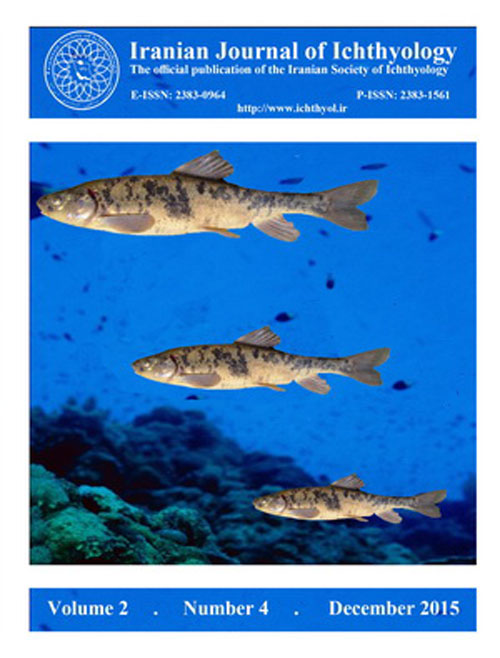فهرست مطالب

Iranian Journal of Ichthyology
Volume:4 Issue: 2, Jun 2017
- تاریخ انتشار: 1396/03/31
- تعداد عناوین: 7
-
-
Pages 75-130The systematics, morphology, distribution, biology, economic importance and conservation of the freshwater mullets of Iran are described, the species are illustrated, and a bibliography on these fishes in Iran is provided. Two species are found in the Caspian Sea basin as exotics (Chelon auratus, C. saliens), two species in southern Iranian fresh waters as native species (Mugil cephalus, Planiliza abu) and two species in brackish waters of rivers (Ellochelon vaigiensis, C. subviridis).Keywords: Biology, Morphology, Mugilidae, Chelon, Ellochelon, Liza, Mugil, Planiliza
-
Pages 131-139This study was aimed to report the presence of the genus Cobitis in the Karaj River, Namak Lake basin, Iran and clarify its taxonomic status by providing morphological characteristics, mtDNA COI barcode region and its phylogenetic relationship within the members of the genus Cobitis in Iran. The results revealed that morphometric, meristic and molecular (COI) characters of these specimen are largely overlapping or even identical with those of C. faridpaki. Therefore, we conclude that they are a population belonging to C. faridpaki.Keywords: Taxonomy, Morphology, COI, Spined loach, Distribution
-
Pages 140-149Chocolate Mahseer, Neolissochilus hexagonolepis is an important food and game fish of North Eastern region of the country, particularly the high lands of Meghalaya. Reproductive biology of the species has been done under the climatic condition of Meghalaya to understand the gonadal development. The gonadal structure and development stages of germ cells of N. hexagonolepis are described for both sexes. Five stages of development are described based on the histological characteristics of testis and ovary. The kind of development and the presence of postovulatory follicles in ovaries which still contain developing vitellogenic oocytes suggest that N. hexagonolepis spawns over a relatively prolonged period of time.Keywords: Chocolate Mahseer, Gonadal Maturity, Spawning Period, GSI
-
Reproductive performance and intestinal bacterial changes of Carassius auratus fed supplemented lactoferrin and Lactobacillus rhamnosus PTCC 1637 dietPages 150-161This study broadens research in to improving the reproduction and intestinal microflora of Carassius auratus broods stocks via lactoferrin and Lactobacillus rhamnosus PTCC 1637 in 120 days. The experimental treatments included: L. rhamnosus PTCC 1637 (106 CFU g diet-1), lactoferrin (200mg kg diet-1) a combined treatment (L. rhamnosus PTCC 1637 with lactoferrin) and a control group in three replications. On the basis of results, the highest (pKeywords: Reproduction, Bovine lactoferrin, Probiotic, Gold crucian carp
-
Pages 162-170In this study, the feeding habits and reproductive behavior of narrow-barred Spanish mackerel, Scomberomorus commerson, in the northern Persian Gulf during five months from October 2011 to December 2012 have been investigated. Specimens were purchased from the fishermen at several landing sites. Feeding and nutrition results showed that sardines are the major prey items of S. commerson. Secondary prey species included ponyfish, halfbeak and Indian mackerel fishes. Mature females (Stages III, IV) were mostly observed between April to July. By July, most of the studied fishes were in recovery or spent stages (Stages IV, V) indicating the end of the spawning season. The result of gonado-somatic index (GSI) study in 184 male and female specimens indicated the highest reproductive activity from April to July with the peak in July. The total sex ratio of 69 males and 115 females was 0.6:1 and it was not significantly different during study periods except autumn season. The minimum and maximum cavity index (CV) for both sexes were from 22.5% in December to 68.0% in October, respectively. Sardines were the most prevalent components of the diet of S. commerson. Based on the obtained results, it can be suggested that that banning of the Spanish mackerel catch in the June-July, which is the peak of spawning period, may help brood stocks. Banning the sardine catch may also benefit management of S. commerson in the Persian Gulf.Keywords: Reproductive Biology, Gonado-somatic Index, Diet, Persian Gulf
-
Reproductive biology of Alburnus mossulensis (Teleostei: Cyprinidae) in Gamasiab River, western IranPages 171-180In the present investigation, some reproductive characteristics of Alburnus mossulensis were examined. Sampling of 325 specimens were carried out at monthly intervals from Gamasiab River, Tigris River drainage, western Iran, through the year 2013. Age, sex ratio, fecundity, oocytes diameter, gonadosomatic (GSI), modified gonadosomatic, Dobriyal and hepatosomatic indices were measured. Regression analysis was used to estimate the relations between fecundity and standard length, body weight, gonad weight and age. All of the male with 70.0mm and female with 75.0mm in standard length, and all of those older than one year were ripe. The mean egg diameter ranged from 0.11mm (August) to 0.84mm (May). Spawning took place in May, when the water temperature was 18 to 22°C. Average GSI values for females at the beginning of the reproduction period (March) and in ripe mature females (May) were 5.05% and 12.03%, respectively. The averages of absolute and relative fecundity (g/body weight) were 1920 eggs (±1025SD) and 99.03 (±94), respectively. The absolute fecundity was significantly related to body length and ovary weight.Keywords: Cyprinid Fish, Spawning Season, Hepatosomatic Index, Gonadosomatic Index, Persian Gulf
-
Pages 181-187Length-weight relationship (TL-BW) and condition factors of 654 female skinnycheek lanternfish, Benthosema pterotum, were evaluated in the Iranian shelf region of Makran (Oman) Sea from April 2013 through March 2014. Prediction of growth pattern was done using a log-transferred of the power function. Analyzing the coefficient b, demonstrated negative allometric growth in juveniles and isometric in adults. The TL-BW relationships obtained were BW= 0.0173TL2.396 and BW=0.0074TL2.933 for juveniles and adults and BW=0.0164TL2.429 for all. The lowest adult condition factor was recorded in summer with an ascending towards spring with the highest value in this season. This value increased from spring to winter in juveniles with the highest value in winter. This trend in juveniles maybe results as better feeding condition in winter, while in adults, it could be affected by the reproductive condition.Keywords: LWR, Coefficient b, Growth Pattern, Juveniles, Adults

